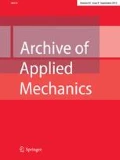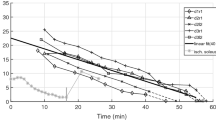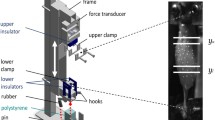Abstract
In terrestrial locomotion, the soft-tissue masses of the body undergo damped oscillations following leg impacts with the ground. Appropriate biomechanical models, therefore, describe gross soft-tissue dynamics by “wobbling masses”. We calculated mechanical energy balances of shank and thigh wobbling masses of the stance leg for the first 90 ms after touch-down in human heel-toe running. Thereto, we re-visited a data set on wobbling mass kinematics which had formerly been gained non-invasively by acquiring the motion of grids of lines painted on the skin of the corresponding muscle masses with high-speed cameras. We found frequencies ranging from 3 Hz to 55 Hz and maximum wobbling mass excursions relative to the bone ranging from 3 mm to 4 cm for the centres of mass and from 2.2° to 11.4° for the rotations. The rotational energy balance is practically neutral (±1 J). Usually, there is clearly more energy that is dissipated by wobbling mass movement in horizontal (thigh: <50 J) than in vertical direction (thigh: <15 J). There is less energy dissipated in the shank (horizontal: <10 J, vertical: <5 J). We argue that the energetic costs of separating significant wobbling masses from the skeleton may be over-compensated by avoiding metabolic costs of active impact reduction and by decreasing loads on passive skeletal structures, in particular when distal leg masses are functional, as in humans. Within reasonable biological limits, impacts are known to be even necessary for structural strengthening of bones. Beyond that, impacts might also be useful for stabilising locomotion, both by increasing basins of attraction and by providing simple mechanical signals for control.
Similar content being viewed by others
References
Alonso F.J., Del Castillo J.M., Pintado P.: Motion data processing and wobbling mass modelling in the inverse dynamics of skeletal models. Mech. Mach. Theory 42(9), 1153–1169 (2007)
Bisseling R.W., Hof A.L.: Handling of impact forces in inverse dynamics. J. Biomech. 39(13), 2438–2444 (2006)
Blickhan R., Seyfarth A., Geyer H., Grimmer S., Wagner H., Günther M.: Intelligence by mechanics. Philos. Trans. Ser. A Math. Phys. Eng. Sci. 365(1850), 199–220 (2007)
Blum, Y., Lipfert, S.W., Rummel, J., Seyfarth, A.: Swing leg control in human running. Bioinspir. Biomim. (2010) [Epub ahead of print]
Boyer K.A., Nigg B.M.: Soft tissue vibrations within one soft tissue compartment. J. Biomech. 39(4), 645–651 (2006)
Boyer K.A., Nigg B.M.: Quantification of the input signal for soft tissue vibration during running. J. Biomech. 40(8), 1877–1880 (2007)
Davis B.L., Cavanagh P.R., Sommer H.J. III, Wu G.: Ground reaction forces during locomotion in simulated microgravity. Aviat. Space Environ. Med. 67(3), 235–242 (1996)
Denoth J.: The dynamic behaviour of a three link model of the human body during impact with the ground. In: Winter, D.A., Norman, R.W., Wells, R.P., Hayes, K.C., Patla, A.E. (eds) Biomechanics IX-A, Volume 5B of International Series on Biomechanics, pp. 102–106. Human Kinetics, Champaign (1985)
Denoth J., Gruber K., Ruder H., Keppler M.: Forces and torques during sports activities with high accelerations. In: Perren, S.M., Schneider, E. (eds) Biomechanics: Current interdisciplinary research, International Series on Biomechanics, pp. 663–668. Martinus Nijhoff, Amsterdam (1985)
Gittoes M.J.R., Brewin M.A., Kerwin D.G.: Soft tissue contributions to impact forces simulated using a four-segment wobbling mass model of forefoot-heel landings. Hum. Mov. Sci. 25(6), 775–787 (2006)
Grimmer S., Ernst M., Günther M., Blickhan R.: Running on uneven ground: leg adjustment to vertical steps and self-stability. J. Exp. Biol. 211(Pt 18), 2989–3000 (2008)
Gruber K., Denoth J., Stuessi E., Ruder H.: The wobbling mass model. In: Jonsson, B. (eds) Biomechanics X-B, Volume 6B of International Series on Biomechanics, pp. 1095–1099. Human Kinetics, Champaign (1987)
Gruber K., Ruder H., Denoth J., Schneider K.: A comparative study of impact dynamics: wobbling mass model versus rigid body models. J. Biomech. 31(5), 439–444 (1998)
Günther M., Blickhan R.: Joint stiffness of the ankle and the knee in running. J. Biomech. 35(11), 1459–1474 (2002)
Günther M., Sholukha V.A., Keßler D., Wank V., Blickhan R.: Dealing with skin motion and wobbling masses in inverse dynamics. J. Mech. Med. Biol. 3(3/4), 309–335 (2003)
Järvinen T.L., Kannus P., Sievanen H., Jolma P., Heinonen A., Järvinen M.: Randomized controlled study of effects of sudden impact loading on rat femur. J. Bone Miner. Res. 13(9), 1475–1482 (1998)
Jorgensen L., Crabtree N.J., Reeve J., Jacobsen B.K.: Ambulatory level and asymmetrical weight bearing after stroke affects bone loss in the upper and lower part of the femoral neck differently: bone adaptation after decreased mechanical loading. Bone 27(5), 701–707 (2000)
Karlsson D., Tranberg R.: On skin movement artefact-resonant frequencies of skin markers attached to the leg. Hum. Mov. Sci. 18(5), 627–635 (1999)
Keppler V., Günther M.: Visualization and quantification of wobbling mass motion—a direct non-invasive method. J. Biomech. 39(1), 53 (2006)
Kraus C., Bock H.G., Mutschler H.: Parameter estimation for biomechanical models based on a special form of natural coordinates. Multibody Syst. Dyn. 13(1), 101–111 (2005)
Lafortune M.A.: Three-dimensional acceleration of the tibia during walking and running. J. Biomech. 24(10), 877–886 (1991)
Liu W., Nigg B.M.: A mechanical model to determine the influence of masses and mass distribution on the impact force during running. J. Biomech. 33(2), 219–224 (2000)
Mills C., Pain M.T.G., Yeadon M.R.: The influence of simulation model complexity on the estimation of internal loading in gymnastics landings. J. Biomech. 41(3), 620–628 (2008)
NASA Reference Publication. Anthropometric Source Book. Technical Report 1024, I-III, NASA Scientific and Technical Information Office, Springfield (1978)
Nigg B.M., Denoth J.: Belastung des menschlichen Bewegungsapparates aus der Sicht der Biomechanik. In: Nigg, B.M., Denoth, J. (eds) Sportplatzbeläge, pp. 33–77. Juris, Zürich (1980)
Nigg B.M., Liu W.: The effect of muscle stiffness and damping on simulated impact force peaks during running. J. Biomech. 32(8), 849–856 (1999)
Pain M.T.G., Challis J.H.: The role of the heel pad and shank soft tissue during impacts: a further resolution of a paradox. J. Biomech. 34(3), 327–333 (2001)
Pain M.T.G., Challis J.H.: Soft tissue motion during impacts: their potential contributions to energy dissipation. J. Appl. Biomech. 18(3), 231–241 (2002)
Pain M.T.G., Challis J.H.: Wobbling mass influence on impact ground reaction forces: a simulation model sensitivity analysis. J. Appl. Biomech. 20(3), 309–316 (2004)
Pain M.T.G., Challis J.H.: The influence of soft tissue movement on ground reaction forces, joint torques and joint reaction forces in drop landings. J. Biomech. 39(1), 119–124 (2006)
Seyfarth A., Geyer H., Herr H.: Swing-leg retraction: a simple control model for stable running. J. Exp. Biol. 206(15), 2547–2555 (2003)
Stelzer M., Stryk O.: Efficient forward dynamics simulation and optimization of human body dynamics. Zeitschrift für Angewandte Mathematik und Mechanik 86(10), 828–840 (2006)
Taaffe D.R., Robinson T.L., Snow C.M., Marcus R.: High-impact exercise promotes bone gain in well-trained female athletes. J. Bone Miner. Res. 12(2), 255–260 (1997)
Wakeling J.M., Liphardt A., Nigg B.M.: Muscle activity reduces soft-tissue resonance at heel-strike during walking. J. Biomech. 36(12), 1761–1769 (2003)
Wakeling J.M., Nigg B.M.: Modification of soft tissue vibrations in the leg by muscular activity. J. Appl. Physiol. 90(2), 412–420 (2001)
Wakeling J.M., Nigg B.M.: Soft-tissue vibrations in the quadriceps measured with skin mounted transducers. J. Biomech. 34(4), 539–543 (2001)
Wakeling J.M., Nigg B.M., Rozitis A.I.: Muscle activity damps the soft tissue resonance that occurs in response to pulsed and continuous vibrations. J. Appl. Physiol. 93(3), 1093–1103 (2002)
Winter D.A.: Biomechanics and Motor Control of Movement. 2nd edn. Wiley, New York (1990)
Wojtyra M.: Multibody simulation model of human walking. Mech. Based Des. Struct. Mach. 31(3), 357–379 (2003)
Yeow C.H., Lee P.V.S., Goh J.C.H.: Effect of landing height on frontal plane kinematics, kinetics and energy dissipation at lower extremity joints. J. Biomech. 42(12), 1967–1973 (2009)
Yue Z., Mester J.: A model analysis of internal loads, energetics, and effects of wobbling mass during the whole-body vibration. J. Biomech. 35(5), 639–647 (2002)
Zadpoor A.A., Nikooyan A.A.: A mechanical model to determine the influence of masses and mass distribution on the impact force during running—a discussion. J. Biomech. 39(2), 388–390 (2006)
Zadpoor A.A., Nikooyan A.A., Arshi A.R.: A model-based parametric study of impact force during running. J. Biomech. 40(9), 2012–2021 (2007)
Author information
Authors and Affiliations
Corresponding author
Rights and permissions
About this article
Cite this article
Schmitt, S., Günther, M. Human leg impact: energy dissipation of wobbling masses. Arch Appl Mech 81, 887–897 (2011). https://doi.org/10.1007/s00419-010-0458-z
Received:
Accepted:
Published:
Issue Date:
DOI: https://doi.org/10.1007/s00419-010-0458-z




